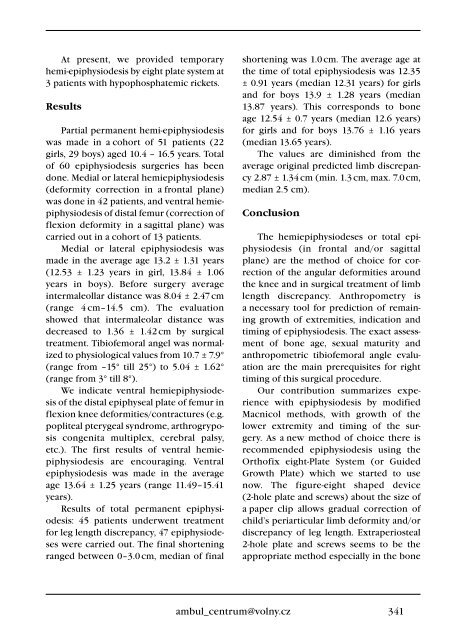3+4+Supplementum/2012 - Společnost pro pojivové tkáně
3+4+Supplementum/2012 - Společnost pro pojivové tkáně
3+4+Supplementum/2012 - Společnost pro pojivové tkáně
- TAGS
- www.pojivo.cz
You also want an ePaper? Increase the reach of your titles
YUMPU automatically turns print PDFs into web optimized ePapers that Google loves.
At present, we <strong>pro</strong>vided temporary<br />
hemi-epiphysiodesis by eight plate system at<br />
3 patients with hypophosphatemic rickets.<br />
Results<br />
Partial permanent hemi-epiphysiodesis<br />
was made in a cohort of 51 patients (22<br />
girls, 29 boys) aged 10.4 – 16.5 years. Total<br />
of 60 epiphysiodesis surgeries has been<br />
done. Medial or lateral hemiepiphysiodesis<br />
(deformity correction in a frontal plane)<br />
was done in 42 patients, and ventral hemiepiphysiodesis<br />
of distal femur (correction of<br />
flexion deformity in a sagittal plane) was<br />
carried out in a cohort of 13 patients.<br />
Medial or lateral epiphysiodesis was<br />
made in the average age 13.2 ± 1.31 years<br />
(12.53 ± 1.23 years in girl, 13.84 ± 1.06<br />
years in boys). Before surgery average<br />
intermaleollar distance was 8.04 ± 2.47 cm<br />
(range 4 cm–14.5 cm). The evaluation<br />
showed that intermaleolar distance was<br />
decreased to 1.36 ± 1.42 cm by surgical<br />
treatment. Tibiofemoral angel was normalized<br />
to physiological values from 10.7 ± 7.9°<br />
(range from –15° till 25°) to 5.04 ± 1.62°<br />
(range from 3° till 8°).<br />
We indicate ventral hemiepiphysiodesis<br />
of the distal epiphyseal plate of femur in<br />
flexion knee deformities/contractures (e.g.<br />
popliteal pterygeal syndrome, arthrogryposis<br />
congenita multiplex, cerebral palsy,<br />
etc.). The first results of ventral hemiepiphysiodesis<br />
are encouraging. Ventral<br />
epiphysiodesis was made in the average<br />
age 13.64 ± 1.25 years (range 11.49–15.41<br />
years).<br />
Results of total permanent epiphysiodesis:<br />
45 patients underwent treatment<br />
for leg length discrepancy, 47 epiphysiodeses<br />
were carried out. The final shortening<br />
ranged between 0–3.0 cm, median of final<br />
ambul_centrum@volny.cz<br />
shortening was 1.0 cm. The average age at<br />
the time of total epiphysiodesis was 12.35<br />
± 0.91 years (median 12.31 years) for girls<br />
and for boys 13.9 ± 1.28 years (median<br />
13.87 years). This corresponds to bone<br />
age 12.54 ± 0.7 years (median 12.6 years)<br />
for girls and for boys 13.76 ± 1.16 years<br />
(median 13.65 years).<br />
The values are diminished from the<br />
average original predicted limb discrepancy<br />
2.87 ± 1.34 cm (min. 1.3 cm, max. 7.0 cm,<br />
median 2.5 cm).<br />
Conclusion<br />
The hemiepiphysiodeses or total epiphysiodesis<br />
(in frontal and/or sagittal<br />
plane) are the method of choice for correction<br />
of the angular deformities around<br />
the knee and in surgical treatment of limb<br />
length discrepancy. Anthropometry is<br />
a necessary tool for prediction of remaining<br />
growth of extremities, indication and<br />
timing of epiphysiodesis. The exact assessment<br />
of bone age, sexual maturity and<br />
anthropometric tibiofemoral angle evaluation<br />
are the main prerequisites for right<br />
timing of this surgical <strong>pro</strong>cedure.<br />
Our contribution summarizes experience<br />
with epiphysiodesis by modified<br />
Macnicol methods, with growth of the<br />
lower extremity and timing of the surgery.<br />
As a new method of choice there is<br />
recommended epiphysiodesis using the<br />
Orthofix eight-Plate System (or Guided<br />
Growth Plate) which we started to use<br />
now. The figure-eight shaped device<br />
(2-hole plate and screws) about the size of<br />
a paper clip allows gradual correction of<br />
child’s periarticular limb deformity and/or<br />
discrepancy of leg length. Extraperiosteal<br />
2-hole plate and screws seems to be the<br />
ap<strong>pro</strong>priate method especially in the bone<br />
341

















